
Yes. I remember Adlestrop -
The name, because one afternoon
Of heat the express-train drew up there
Unwontedly. It was late June.
The steam hissed. Someone cleared his throat.
No one left and no one came
On the bare platform. What I saw
Was Adlestrop - only the name
And willows, willow-herb, and grass,
And meadowsweet, and haycocks dry,
No whit less still and lonely fair
Than the high cloudlets in the sky.
And for that minute a blackbird sang
Close by, and round him, mistier,
Farther and farther, all the birds
Of Oxfordshire and Gloucestershire.
'Yes I remember Adlestrop -
The name,...'
This is surely the most evocative start of any of Edward Thomas’s poems. The poem brings clearly to mind the unscheduled halt of a steam train and its passengers at a railway station in Gloucestershire on a summer’s day. It has become his best known poem and a favourite of the nation, evoking wistful images of Edwardian prelapsarian summers, and the English countryside stretching ever outward.
The poem has been much written about and I am loath to venture where other wiser heads have gone before. But one field note book in particular sheds new light on the poem. It’s already well known that the elements of the poem came from two separate stops on a train journey to Ledbury in Gloucestershire that Edward Thomas and his wife were making to stay with the Frosts. This has been identified by Edna Longley in her annotated complete poems of Edward Thomas as well as by others. However another earlier note book also shows ET would have had some familiarity with Adlestrop “the name”, before he passed through the station on that late June day.
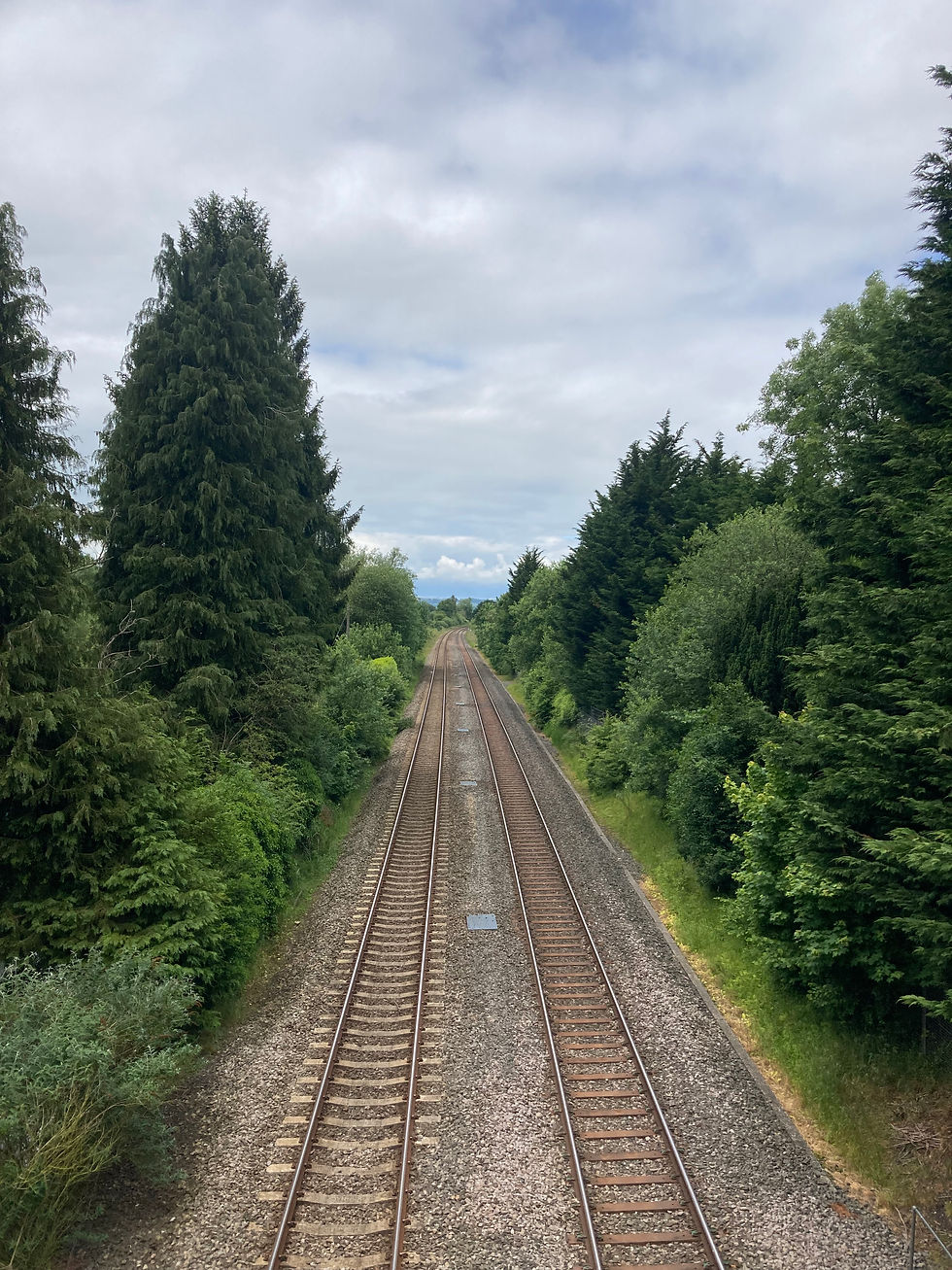
The origins of the poem can be found in the later notebook, FNB 75. On the 24th June he and Helen travelled from London to Ledbury in Gloucestershire via Oxford.
It was “a glorious day from 4.20 am & at 10 tiers above tiers of white cloud with dirtied grey bases above the sea of slate & dull brick by Battersea Park.”
At Oxford he saw “tiers of pure white with loose large masses above & gaps of dark clear blue above haymaking & elms.”
The train went on to Gloucestershire via Charlbury and then “we stopped at Adlestrop through the willows could be heard a chain of blackbirds songs at 12.45 & one thrush & no man seen, only a hiss of engine letting off steam.” The railway line followed the upper valley of the River Evenlode through meadows and osier beds.
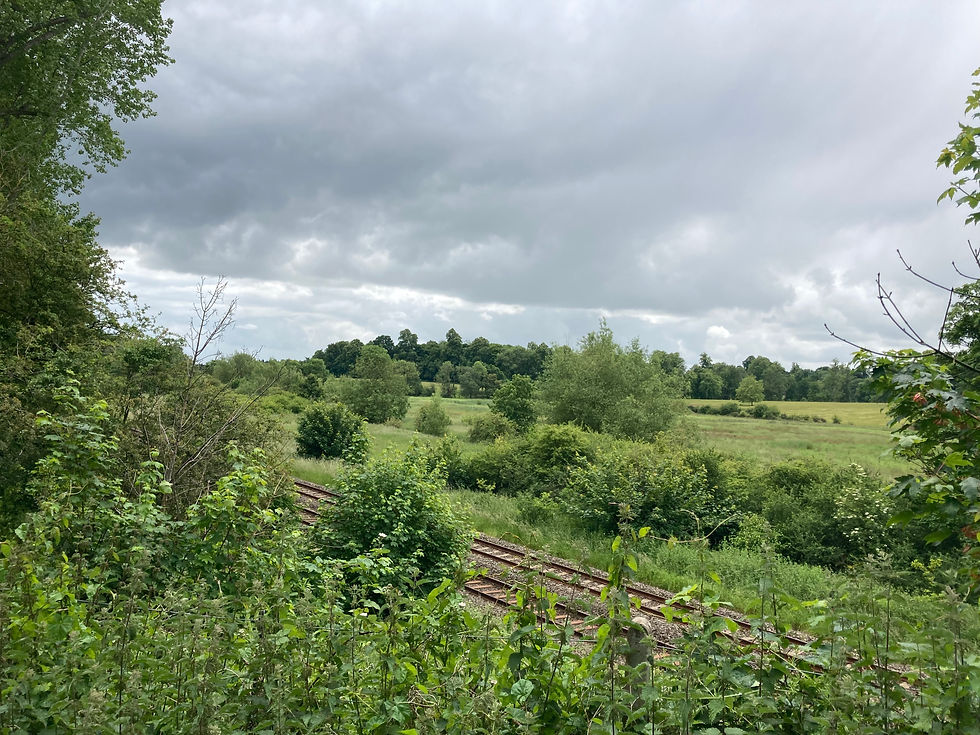
The next unscheduled stop was just outside Chipping Campden where he saw “banks of long grass, willowherb & meadowsweet". He described the "extraordinary silence between the two periods of travel - looking out on grey dry stones between metals & the shining metals & over it all the elms, willows & long grass - one man clears his throat - a greater than rustic silence. No house is near/in view”. The train stopped only for a minute before the signal came down. (The willowherb he saw was probably greater willowherb, not the (now) more common rosebay which he would identify by name in his notebook.)
He may have been writing this after the event, for below these entries he wrote “Another stop like this outside Colwall on 27th with thrush singing on hillside above on right/road” Colwall is between Ledbury and Malvern and he and Helen were leaving Dymock after a few days to travel up to Coventry to see friends from Bedales School, who would later provide lodgings for their son, Mervyn.
So the original inspiration behind the poem were these separate stops which ET combined into one resonant event at Adlestrop station. There is an elegiac feeling to the poem, though written only nine months afterwards and a few months after the war had started. In the poem the memory of the event seems to be triggered by the name, Adlestrop, a place only known from the brief stop.
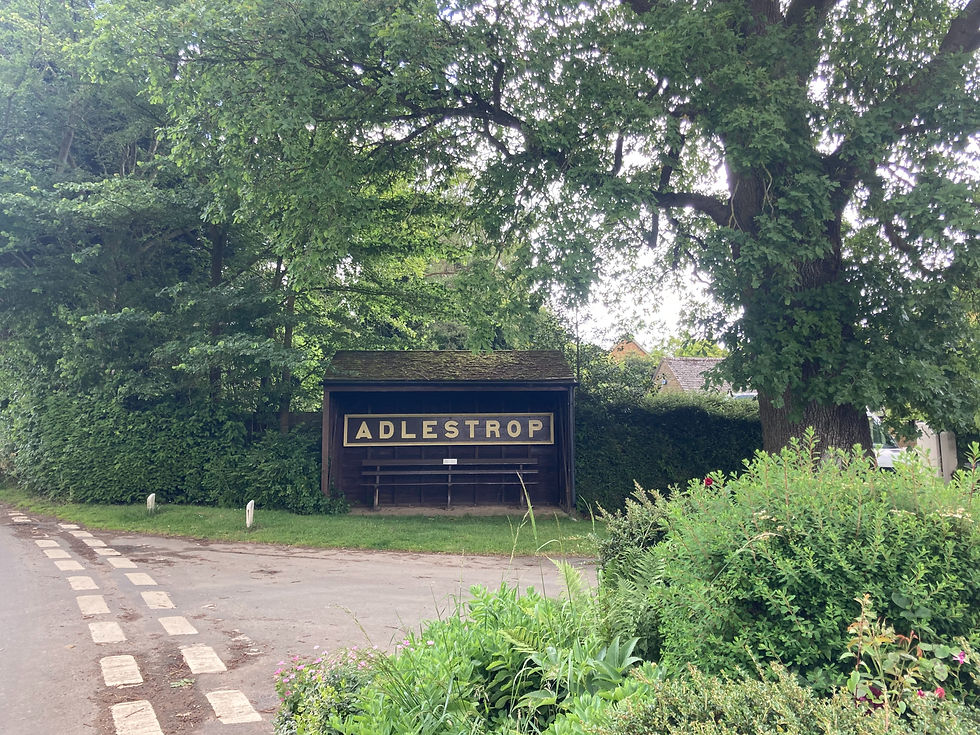
Yet ET would have been familiar with the name of Adlestrop from when he had stayed close by the village a few weeks before his train drew up there. He had stayed in the neighbouring village of Kingham, a couple of miles south of Adlestrop, above the upper Evenlode in early May. He went there at the invitation of his great friend Eleanor Farjeon who was staying there with her brother, Bertie and Joan Thornycroft, who Bertie would later marry. They had taken a house there for a brief holiday. ET was keen to join the party though Helen could not make it. He had written in a letter to Eleanor when making the arrangements “You will like Kingham which I know a lot about, because a former sub-rector of my college (Lincoln, Oxford) lives there (and wrote a history of it later) Warde Fowler.”
ET went on condition he would have time to work - he was writing A Literary Pilgrim in England at the time, a commission which he was not enjoying. He would work on it for a few hours in the early morning. Otherwise they explored the country all around during the day (as ET said it was too early to fish except for trout). They walked many miles through meadows and up paths, lanes and streams to the higher ground all around, looking round the villages and the local churches and their church yards. In the evening they conversed, joked, smoked and played games. ET noted down the walks and sights he had seen in his field notebook (FNB74).

On his walks, normally with Eleanor, as Joanne liked to paint and Bertie attended her, he would have seen signposts pointing to Adlestrop at a number of crossroads. In particular. he came within a mile or so of Adlestrop on the most extended of his walks to the Rollright Stones. The walk on the penultimate day of their stay took them from Kingham up on to the high ridge half way between Moreton in the Marsh and Chipping Norton. Crossing the lane between Cornwell and Adlestrop he would have seen a sign to Adlestrop and also at the main road at the top where he turned right along the ridge, away from Adlestrop, only a little over a mile away to the west.
Is it too fanciful to envisage, six weeks later as the train stopped at Adlestrop and Edward and Helen looked out of their carriage window, that he remembered the name Adlestrop from his earlier stay at Kingham. In which case the words at the beginning of the poem, recalling that stop, written the following January, would have been an echo of what he had thought, or maybe had said to Helen, in the carriage that day.
Originally the poem’s first lines read
“Yes, I remember Adlestrop
At least the name.”
The full stop sets the statement more apart from the experience at the station than the comma of the finished version. They could also be the actual words he used to Helen when recalling his previous encounter with the name, Adlestrop, on his walks round Kingham. On that June day they would have just passed through, and probably stopped at the previous station, Chipping Norton junction, which ET would have alighted at when he came to stay at Kingham six weeks before. So they may easily have been talking about his stay there, having passed through countryside he was recently familiar with, when they drew up at Adlestrop, prompting the remark. All this is speculation but it seems very likely that the recall of that day would have also triggered a memory of coming across the name further back, so a memory of a memory of Adlestrop.
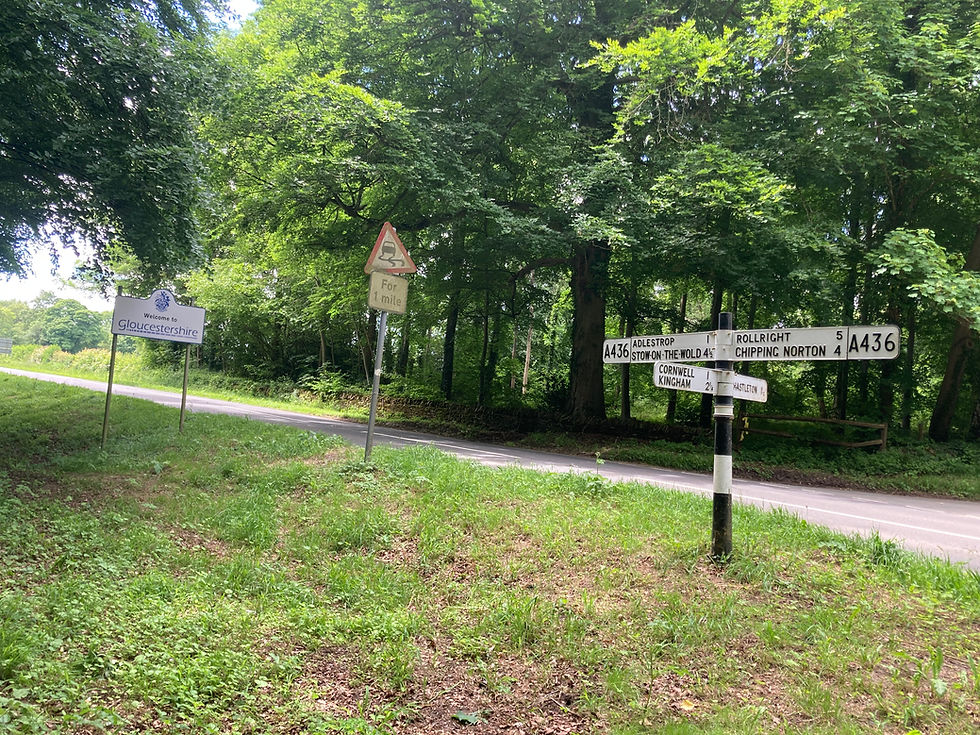
The other sign he would have seen regularly on his walks were the county signs of Oxfordshire and Gloucestershire. He criss-crossed the county border a few times during his stay at Kingham. Kingham was in Oxfordshire but Bledington, a short walk away on the other side of the Evenlode was in Gloucestershire and he had visited there at least twice during his stay.
On the walk to the Rollright stones he would have seen the county sign at the point he turned right, east along the high ridge. And there would have been constant reminders he was in Oxfordshire as Oxford County surmounted every sign post. So he could state confidently that sitting at Adlestrop station for the first time, that he could hear the birds of Oxfordshire and Gloucestershire all around.
The ever-widening circle of bird song that he heard as he sat on the train at the station was something he had observed quite frequently before. In July 1909 he had noted at their home under the Hampshire hangers at Berryfield:
“A thrush in the garden sings clear & a few others, so that tho(ugh) the 2 or 3 near are clear the rest are a remote medley but how unlike the Spring’s - yet one could (walk crossed out) race across England this day & never be out of sound of thrushes…& this song suggests the thought of a beacon line of birds from the East up to my garden.”
In the poem rather than a chain or line of beacons, the bird song is in an ever widening circle, encompassing the name, Adlestrop, at its heart. ET wrote in his essay England about the same time as he was writing the poem: “I believe that all ideas of England are developed, spun out, from such a centre into something large or infinite, solid or airy…that England is a system of vast circumferences circling round the neighbouring points of home.” This belief was matched in his way of exploring the countryside around new places such as Kingham, going round each outer segment in turn until he had fully encircled the place in his mind.

As Edna Longley writes, the rhymes and repetition of the last verse of Adlestrop “make the poem’s echoes linger beyond its last words”. Complementing these echoes of bird song expanding into the space of the two counties, the poet was also hearing an echo in time, within the layers of his memories of the name, Adlestrop.
As well as recalling the name from this earlier time, he may also have recalled the birdsong he had heard when at Kingham.
He had sighted a number of birds there, including many larks, blackcaps, pewits and sparrows. He had also spotted or heard a number of blackbirds.
On the 8th May he had crossed the Evenlode brook (and the county border) and walked up towards Bledington Church, through meadows full of cuckoo flower, dark orchis, cowslips and may. There was a brief shower followed by a rainbow and a blackbird sang “of course…with a yodel.”

On the same walk he saw his old sub-rector from Lincoln, Warde Fowler, in knickerbockers, cap and short coat, peering round short sightedly at who might be following him. Warde Fowler had written books on bird watching round Kingham and also a history of the parish (Kingham Old and New: Studies in a Rural Parish), which included chapters on birds and botany of the locality, that ET had almost certainly read.
On the last day, a Sunday with everything closed, he wrote of “a delicious fragrant almost windless day with white sky grey drift slowly under it.” He saw blackbirds and many larks, with much may “pale among the leaves…& the beeches are pale silken. Roads scattered with pale flat pods/seeds? from Wych elms like hops.” (an image he was to use in his poem May 23).
His descriptions in his notebooks show how much he had enjoyed his stay at Kingham and likewise a trip six weeks later to Ledbury to stay with the Frosts, his second of the year. By the time he wrote the poem he would have gone to Gloucestershire three more times and war had broken out. The stays at Kingham and Dymock would have seemed like an Eden, a world now lost. Their brief stop at Adlestrop, between two favourite places, was also a moment of calm in between ET's continuous activity, a moment to savour and recall at a time when he was confined to his house in mid-winter with a badly sprained ankle.
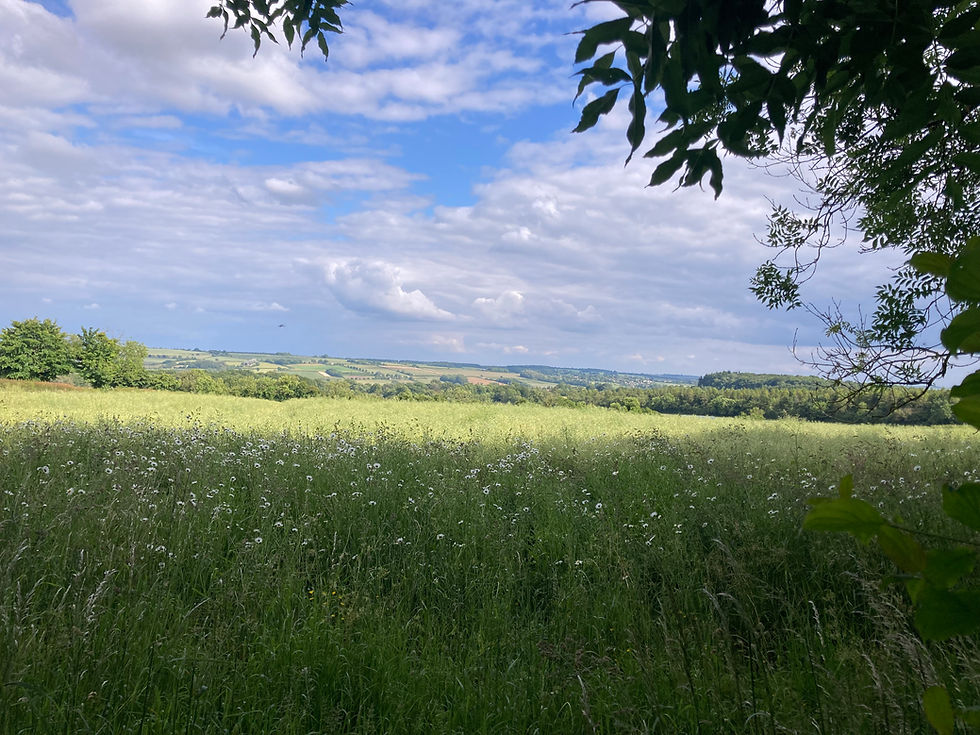
A walk
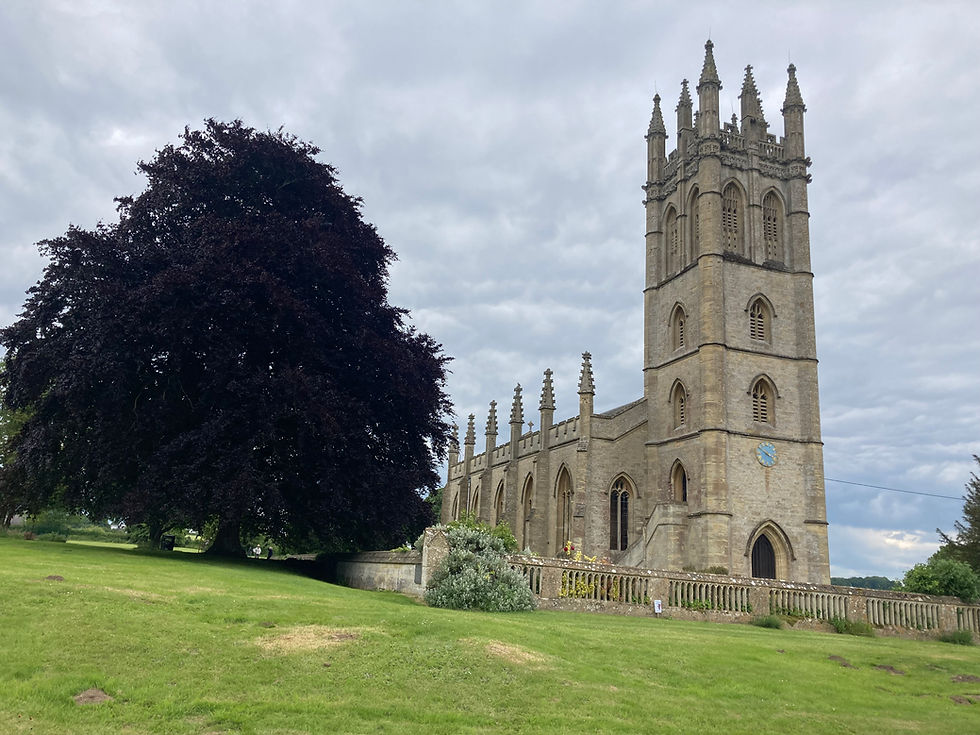
Edward Thomas did long walks with Eleanor Farjeon for four out of the five days he spent at Kingham. As was his habit when arriving at a new place, he explored segments out from the village in different directions. His main omission was up the River Evenlode to Daylesford and, beyond to, Adlestrop!
On the Wednesday (6th May) they walked from Kingham up to Churchill with its impressive church and then into the valley beyond where he explored Sars Brook and Sarsgrove woods. The following day they crossed over the Evenlode below Kingham into Gloucestershire to the neighbouring parish of Bledington, and then walked through meadows full of marigolds, up the brimming Evenlode (towards Adlestrop) before crossing back to the Kingham side.
The following day they explored, beyond Bledington, the high country around the villages of Idbury and Westcote, coming back by Bledington church, where he saw Warde Fowler. On the Saturday he went north east up on to the ridge and along it to the Rollright stones and the village of Little Rollright, picking up some ginger beer on the way. He was impressed by the stones and the views from the ridge into the river valleys on either side and the high country beyond.
From an initial reconnaissance, all of these walks are still doable, using a combination of lanes and paths. I will make another trip to Kingham in the next few months and will come back with a recommended walk or walks round Kingham, supplemented by Edward Thomas’s field notes from FNB74.
Meanwhile below are two extracts from Warde Fowler’s book on Kingham which gives an excellent feel of the country round Kingham at the time Edward Thomas was visiting. Warde Fowler’s book, Kingham Old and New, was published in 1913. A copy of Edward Thomas’s own field note book for his stay in Kingham in May 1914 - FNB 74 - is available on request at the Edward Thomas Study Centre in Petersfield.
“If you take the railway from Oxford to Worcester, you come in a very few minutes upon our stream, the Evenlode ; and following it up along its winding woodland course as far as Charlbury, you then come out upon a more open country, with heights to east and west. You are still following the Evenlode, but no longer in a narrow grassy valley ; here begins an airy open district, the whole of which seems to be cultivated, except an occasional stretch of wood, and the meadows which flank the stream on each side. These last are used for hay in summer and pasture in winter ; other pasture-fields are of course to be seen here and there, but the general look of the slopes and hills suggests a very assiduous cultivation.”

“Kingham lies in what may be called a basin — the wide basin of the Upper Evenlode, whose two tributaries have here formed considerable valleys to east and west of the main stream, giving the whole region, as seen from the hills around us, the appearance of a plain rather than a valley. To this feature of the country is mainly due its healthy breezy climate, which is cold without being too cold. It is a delightful country for an active man to live in, whether he hunts or cycles, or humbly walks, as I do; and my long walks with Colonel Barrow, usually to some point on the hills to east or west of us, were chiefly what fascinated me forty years ago, and fixed me here in time as a resident. True, if our walks had been limited to roads, I might have cared less about the life here; but I soon found that one great glory of Kingham is in the footpaths that lead in every direction, which are not merely short cuts from one point to another, but often stretch away over grass-fields for miles, without once bringing you to the sight of a road. Take, for example, the footpath to Bledington; it crosses the Evenlode and two railways, takes you up to the village, and leads to the extremely interesting church of Bledington by a short fragment of road: then plunges into a vast region of pasture, across which for two miles or so you must trace it with some discrimination, till you begin to climb the Cotswold ridge, and find yourself at last on a road again at the village of Westcote. I have known our late rector, who as a hunting man knew every field here as well as he knew his own garden, completely lost in a fog in this solitary region, when returning on foot from a call. He was forced to find his way back again up the hill to a road.”
Nowadays there are better footpath signs than in Warde Fowler's - or Edward Thomas's - day to guide you round the countryside. However some of the roads are busier and the villages have grown though much of their character has been retained - and the views remain much as they would have seen.
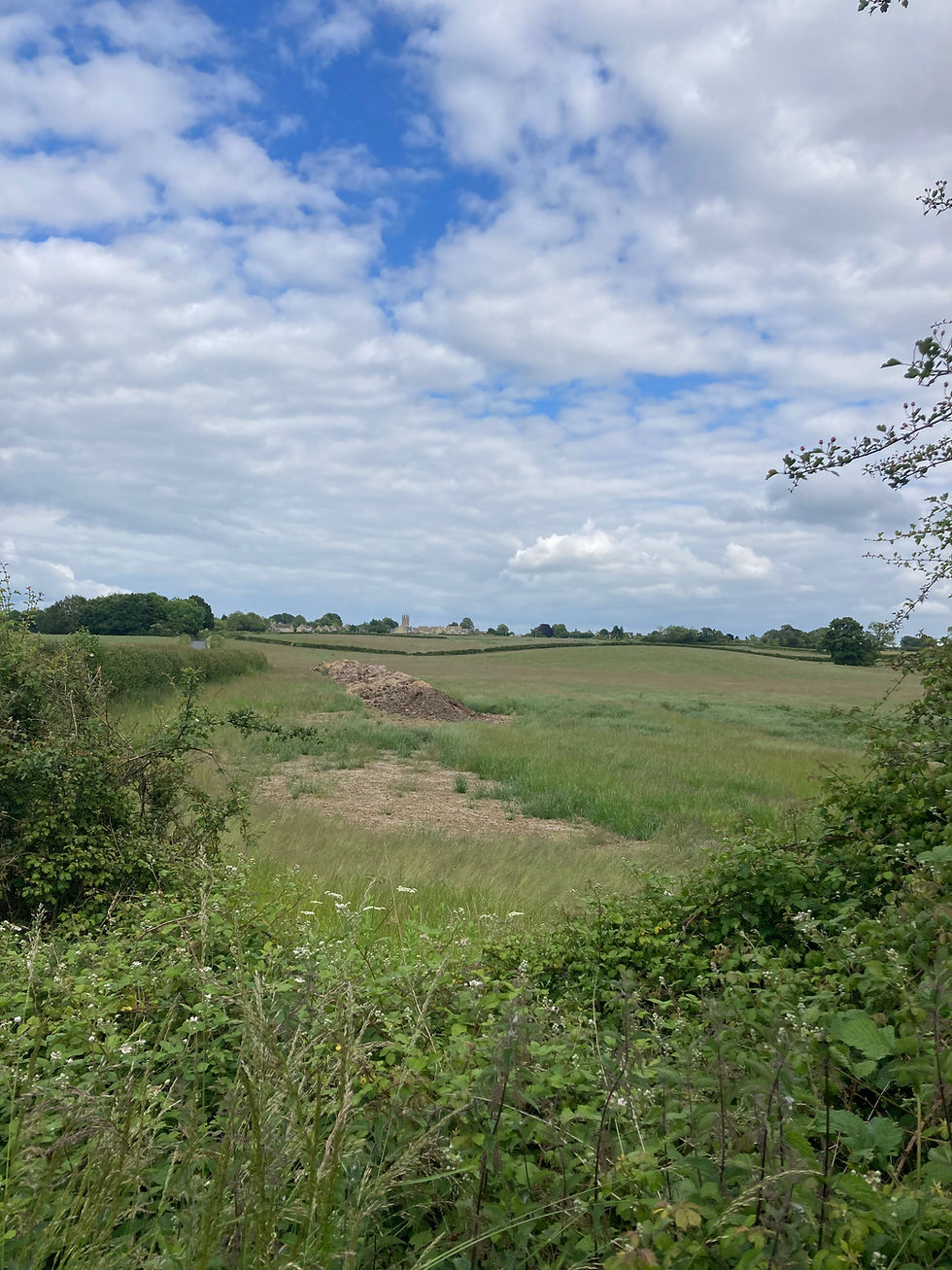
Acknowledgements
Field note book copyright Henry W. and Albert A. Berg Collection, New York
Edward Thomas's England is published in The Last Sheaf
I have also drawn gratefully on Edna Longley's Edward Thomas The Annotated Collected Poems; Eleanor Farjeon's Edward Thomas The Last Four Years and William Warde Fowler's Kingham Old and New.
My thanks as always for Ben Mackay for editorial support.






Comments